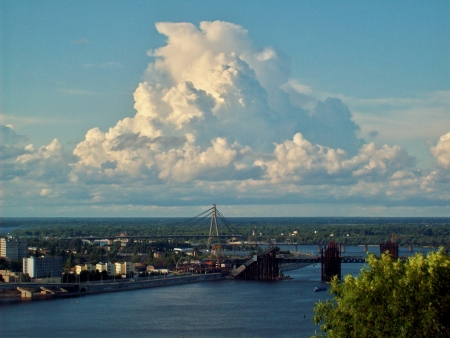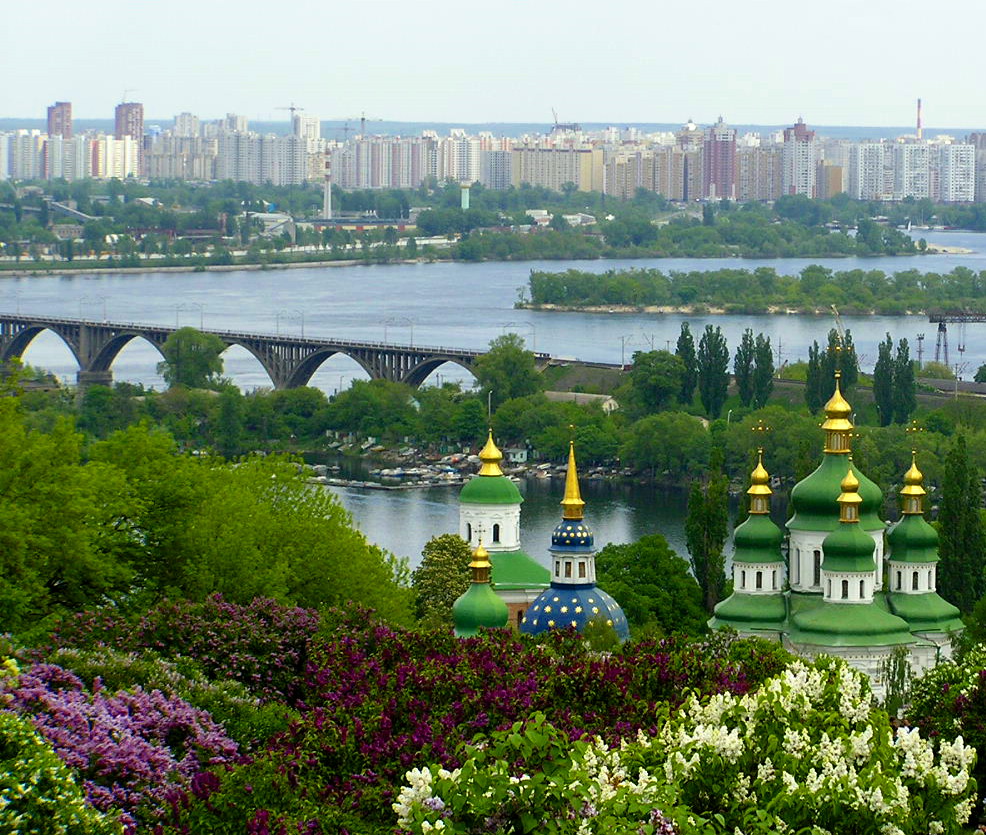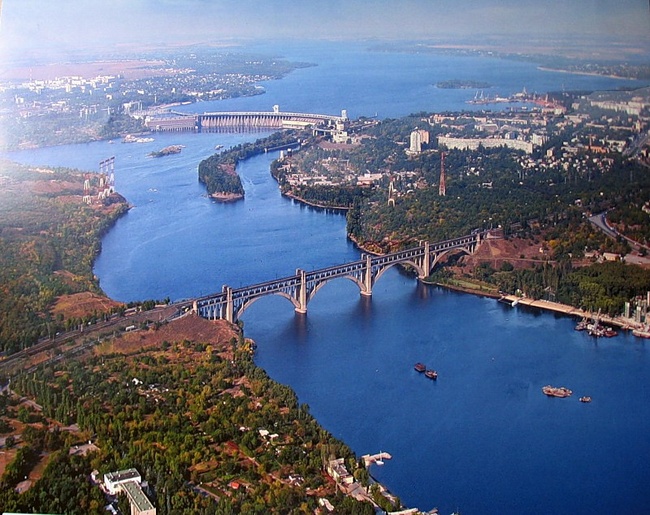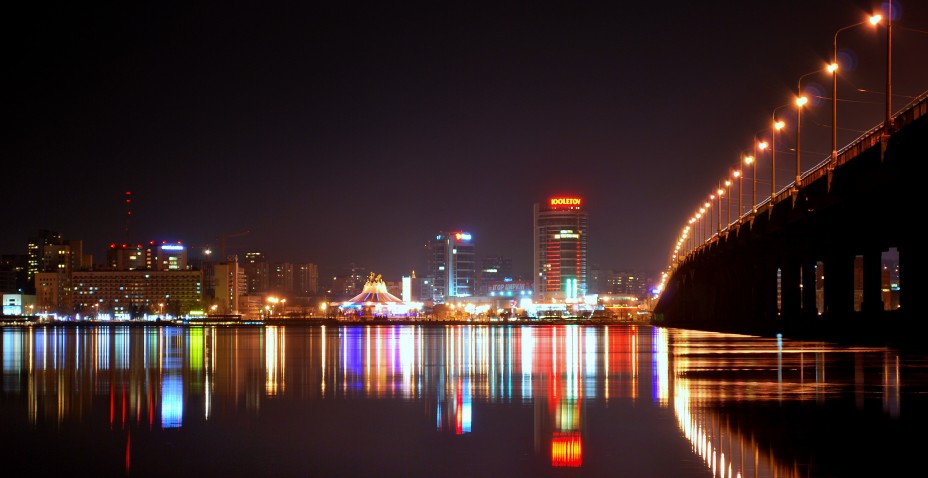|
Dnieper River in ancient Greek (Danapris in Latin of the 4th century). The largest river in Ukraine and the third largest in Europe (after the Volga River and the Danube River). From the dawn of history the Dnieper has been closely bound up with the life of the Ukrainian people. It is the ‘holy river’ of Ukraine. Its length is 2,285 km, of which 485 km lie within the Russian Federation, 595 km within Belarus, and 1,095 km within Ukraine. The Dnieper Basin covers 504,000 sq km, of which 289,000 sq km are within Ukraine (48 percent of its area). The basin occupies 42
percent of the territory of the Ukrainian state and 36 percent of Ukrainian
ethnic territory. The Dnieper flows south through the center of Ukraine and bisects its natural zones — forest,
forest-steppe, and steppe — interconnecting them and connecting them with the Black Sea. Of the long-settled principal areas of Ukraine, only Galicia,
western Volhynia, and Transcarpathia lie beyond the basin of the Dnieper. Travel is easy fr om the Dnieper Basin to basins northwest of it — the Vistula River, the Neman River, and the Daugava River, but difficult to other basins, such as the basins of the Dniester River, the Boh River, the Volga River, and the Don River. Easy communications between the Dnieper River, the Prypiat River, and the Buh River by means of the Vistula facilitated the expansion of Poland into Ukraine. The Dnieper's role as a unifying force and gateway to the sea was, however, weakened by a 70 km stretch of rapids in the steppe belt. In spite of this obstacle, the Dnieper was the main axis of the first Ukrainian state — Kyivan Rus'. The nucleus of a second state — the Zaporozhian Sich — arose on the Dnieper. The river is the artery of Ukraine, its main highway, and its source of hydroelectric power. Physical geography. The Dnieper is a typical river of the plains, sloping gently and flowing slowly. The water level varies considerably, and the riverbed is unstable. There are many shallow parts, but relatively few turns. The Dnieper Rapids, which today are submerged, are a peculiar feature of the Dnieper. The river's general southerly flow can be broken up into several sections: fr om its source to Orsha (Vitsebsk oblast) the Dnieper flows southwest, then south to Kyiv, then southeast to Dnipropetrovske, then south for 90 km as far as Zaporizhia, and finally southwest to the estuary. Thus, the Dnieper forms a large open bow to the east, doubling the route from central Ukraine to the Black Sea (to 950 km, although Kyiv is only 450 km from the sea in a straight line). The river can be divided into three sections: the upper Dnieper from the source to Kyiv (1,333 km, of which 255 km are within Ukraine); the middle, from Kyiv toZaporizhia (536 km), including the above-mentioned stretch of rapids; and the lower, from Zaporizhia to the sea (331 km). The source of the Dnieper lies in the northwest part of the Central Upland — in the Valdai Upland, at an elevation of 220 m, among turf swamps. Down to the town of Dorogobuzh (Smolensk oblast) the Dnieper is a small river, no more than 30 m wide, flowing through a forested plateau. Below Dorogobuzh to Orsha the river becomes wider — 40-120 m and navigable, even by steamship when the water is high. Above Orsha the river cuts into Devonian limestone, forming small rapids known as the Kobeliatskie Rapids. Below Orsha near Rahachou (Homel oblast), the Dnieper enters the Polisia Lowland, and from the town of Loev it flows through Ukrainian territory. From here on the river basin widens considerably, because the largest tributaries are in this section. On Belarusian territory the Biarezina River (613 km long; basin area, 24,530 sq km) joins the Dnieper from the left, and the Sozh River (648 km long; basin area, 41,400 sq km) joins it from the right. On Ukrainian territory the Prypiat River (748 km and 114,300 sq km) and the Desna River (1,126 km and 88,900 sq km) flow into the Dnieper. The Teteriv River (385 km) and Irpin River(162 km) are small tributaries within Ukraine. After the Dnieper receives these rivers, its basin expands to 328,000 sq km (near Kyiv), its width reaches 700 m, and its depth approaches 8 m. The rate of water flow at Orsha is 45 cu m/sec; at Rahachou it is 108 cu m/sec; and at Kyiv it increases to 1,380 cu m/sec. The basin of the upper Dnieper has the densest river network (0.3 km/sq km) and the most rainfall (550–650 mm per year). It is the most forested (25 percent) and swampy section of the Dnieper. The construction of the Dnieper Cascade of Hydroelectric Stations and reservoirs from the mouth of the Prypiat River to the town of Kakhivka (the Kyiv Reservoir, the Kaniv Reservoir, the Kremenchuk Reservoir, the Dniprodzerzhynsk Reservoir, the Kakhivka Reservoir, and Dnieper Reservoir) has led to great changes in the riverbed. The natural riverbed has been preserved only along short sections of the Dnieper: above the mouth of the Prypiat, above Kyiv, below Kaniv and Dniprodzerzhynsk, and below Kakhivka.From Kyiv to Dnipropetrovske the Dnieper flows along the boundary between the Dnieper Upland and the Dnieper Lowland. The river valley is asymmetrical here: the right bank rises to 100–150 m above the river, is deeply dissected by valleys and gullies, and is covered with forest. It forms a picturesque mountain landscape. Kyiv lies in these ‘Dnieper Mountains.’ Below Kyiv, in the Kaniv Hills, is located the grave of Taras Shevchenko. The left bank of the river is low, sandy, and often covered by pine forest. It rises towards the east in broad terraces. The river valley is wide — 6-10 km, and at Pereiaslav-Khmelnytskyi and Cherkasy, 15–18 km — while the river is 200–1,200 m wide. Below Cherkasy the Dnieper splits into sidestreams and creates islands. Its depth varies frequently, from 1.5 to 12 m. The tributaries that empty into the middle Dnieper are smaller than those in the upper Dnieper and carry much less water. The tributaries on the right side — the Stuhna River (68 km), the Ros River (346 km), and the Tiasmyn River (194 km) — flow in short, narrow beds carved in granite. The tributaries on the left originate usually in the Central Upland and cross the whole Dnieper Lowland. They are longer and wider, with low banks and terraces. The rivers are the Trubizh River (113 km), the Supii River (130 km), the Sula River (310 km), the Psol River (692 km), the Vorskla River (425 km), and the Samara River (311 km). They do not greatly increase the water volume of the Dnieper. The slope of the Dnieper between Kyiv and the mouth of the Tiasmyn River is very gentle — 6 cm/km. It becomes steeper wh ere the Dnieper enters the Ukrainian Crystalline Shield. The river dissects the massif for 90 km between Dnipropetrovske and Zaporizhia. Originally it flowed through a narrow, deep (100 m), chiseled valley and formed a typical granite landscape. The riverbed narrowed here to 300–800 m, and at the village of Kichkas near Zaporizhia it contracted to 175 m. Here the renowned Dnieper Rapids rested on a firm, granite foundation. There were 9 rapids and 60 small barriers. The slope of the river reached 50 cm/km, and the current sometimes attained a velocity of 6 m/sec. When a dam was built on the Dnieper above Zaporizhia in 1932 (see Dnieper Hydroelectric Station), the rapids were submerged under Dnieper Reservoir, and the landscape changed completely. |
Авторські права | Privacy Policy |FAQ | Партнери | Контакти | Кейс-уроки
© Автор системы образования 7W и Гипермаркета Знаний - Владимир Спиваковский
При использовании материалов ресурса
ссылка на edufuture.biz обязательна (для интернет ресурсов -
гиперссылка).
edufuture.biz 2008-© Все права защищены.
Сайт edufuture.biz является порталом, в котором не предусмотрены темы политики, наркомании, алкоголизма, курения и других "взрослых" тем.
Ждем Ваши замечания и предложения на email: 
По вопросам рекламы и спонсорства пишите на email: 












